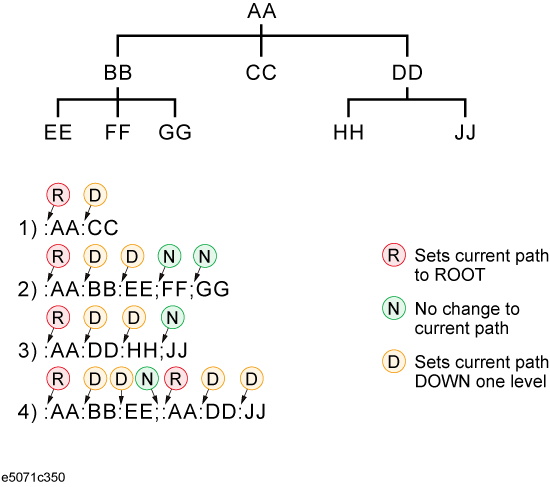
The SCPI commands available for the E5063A are classified into 2 groups as follows.
Commands specific to the E5063A. They cover all measurement functions that the E5063A has and some general-purpose functions. The commands in this group are arranged in a hierarchical structure called the command tree. Each command consists of character strings (mnemonics) indicating each hierarchical level and colon (:) separators between hierarchical levels.
Commands to cover general-purpose functions defined in IEEE488.2 that are available commonly to instruments that support this standard. The commands in this group have an asterisk (*) at the beginning. For the commands in this group, there is no hierarchical structure.
The commands at the top of the command tree are called "root command" or simply "root." To access lower level commands in the tree, you need to specify a specific path like a directory path in the DOS file system. After power-on or reset, the current path is set to the root. Special characters in messages change the path setting as described below.
A message terminator such as the
<new line> character sets the current path to the root.
A colon between 2 command mnemonics lowers the level of the current path in the command tree. A colon used as the first character of a command specifies the command mnemonic that follows as the root-level command.
A semicolon does not change the current path and separates 2 commands in the same message.
The following figure shows an example of how to use colons and semicolons to efficiently access commands in the command tree.
Using colons and semicolons

This section describes the grammar to send program messages via GPIB. Program messages are messages that the user sends to the instrument from the external controller to control the instrument. A program message consists of 1 or more commands and their necessary parameters.
Upper/lower case insensitive.
A program message must be terminated with one of the 3 program message terminators: <new line>, <^END>, or <new line><^END>. <^END> indicates that EOI on the GPIB interface becomes active at the instant when the immediately previous data byte is sent. For example, the OUTPUT command of HTBasic automatically sends the message terminator after the last data byte.
A space (ASCII code: 32) is required between a command and its first parameter. When sending several parameters in a single command, separate each parameter with a comma (,).
When sending 2 or more commands in a single message, separate each command with a semicolon (;). The following example shows how to send the *CLS command and the :SYST:PRES command in a single message using VISA-COM.
Ena.WriteString "*CLS;:SYST:PRES", True
The E5063A does not provide remote mode. Therefore, even if you send a GPIB command, it never enters into the remote mode automatically. There is no local key to release remote mode.
If you need to prevent misoperation during remote control due to entry from the front panel or mouse, lock the input devices using the following commands.
:SYST:KLOC:KBD
:SYST:KLOC:MOUS